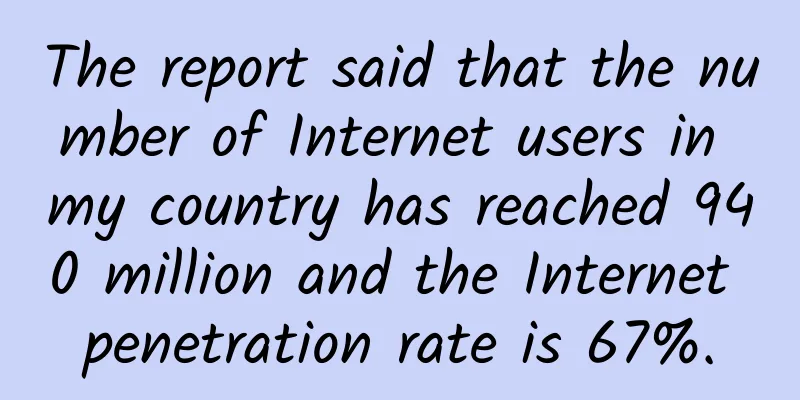The report said that the number of Internet users in my country has reached 940 million and the Internet penetration rate is 67%.

|
The China Internet Network Information Center (CNNIC) released the 46th "Statistical Report on the Development of China's Internet" (hereinafter referred to as the "Report") in Beijing. The Report shows that as of June 2020, the scale of Internet users in my country reached 940 million, an increase of 36.25 million from March 2020, and the Internet penetration rate reached 67.0%, an increase of 2.5 percentage points from March 2020.
The Internet has inspired tremendous power to help achieve a major victory in the fight against the epidemic Wu Tienan, Secretary of the Party Committee and Deputy Director of CNNIC, pointed out that during this epidemic, my country's Internet industry has demonstrated tremendous development vitality and resilience. It has not only played a key role in the precise and effective prevention and control of the epidemic, but also has made significant progress in digital infrastructure, digital economy, digital benefits for the people and digital governance. It has become an important force for my country to respond to new challenges and build a new economy. Zhang Xiao, deputy director of CNNIC, interpreted the report and summarized the highlights of China's Internet development in the first half of 2020 from eight aspects: "Online" gathers strength, and "new forms" help fight the epidemic and stabilize the overall situation. In the first half of the year, online education, online medical care, remote office and other application services played a huge role in maintaining the normal operation of the social economy and stabilizing the basic needs of people's livelihood. As of June 2020, the scale of online education users reached 381 million, accounting for 40.5% of the total number of netizens; the scale of online medical users reached 276 million, accounting for 29.4% of the total number of netizens; the scale of remote office users reached 199 million, accounting for 21.2% of the total number of netizens. "Network" technology, "new infrastructure" injects vitality and expands volume. In the first half of the year, the central government intensively deployed to accelerate the progress of "new infrastructure", and positive progress was made in many important areas: by the end of June 2020, the number of 5G terminal connections had exceeded 66 million, and the three basic telecommunications companies had opened more than 400,000 5G base stations. In the field of industrial Internet, more than 500 industrial Internet platforms with distinctive characteristics and diverse capabilities have been cultivated and formed. As of July 2020, the number of users with allocated IPv6 addresses in my country has reached 1.442 billion, the number of active IPv6 users has reached 362 million, and the top 100 commercial websites and applications have all supported IPv6 access. "Internet" promotes development, "new economy" expands domestic demand and helps transformation. As of June 2020, the scale of users of e-commerce live broadcast, short video and online shopping in my country increased by more than 5% compared with March. The scale of e-commerce live broadcast users reached 309 million, an increase of 44.3 million from March 2020, with a growth rate of 16.7%, becoming the fastest growing personal Internet application in the first half of the year, providing positive support for promoting the transformation of traditional industries and driving the upward trend of agricultural products. The scale of online retail users reached 749 million, accounting for 79.7% of the total number of netizens. The market has remained the world's first for seven consecutive years, providing important support for the formation of a new development pattern. The Internet is warm, and the "new benefits for the people" help alleviate poverty. As of June 2020, the number of Internet users in my country has reached 940 million, equivalent to one-fifth of the world's Internet users. The Internet penetration rate is 67.0%, about 5 percentage points higher than the global average. The urban-rural digital divide has been significantly narrowed, and the difference in Internet penetration rates between urban and rural areas is 24.1%, which has narrowed to less than 30% for the first time since 2017. Internet poverty alleviation, as an important means of poverty alleviation, has been increasingly understood and participated in by Internet users. "Network" brings culture, "new communication" tells stories and sets a new trend. As of June 2020, the scale of online video (including short video) users in my country reached 888 million, accounting for 94.5% of the total number of netizens. Among them, short videos have become a new choice for news reporting and a new standard for e-commerce platforms. The scale of online news users is 725 million, accounting for 77.1% of the total number of netizens. Online news uses social platforms, short videos and other platforms to improve communication efficiency through visualization, helping to promote anti-epidemic publicity and reporting. "Internet" knows the world, "new tools" see the world at close range. As of June 2020, the scale of online payment users in my country reached 805 million, an increase of 4.8% from March 2020, accounting for 85.7% of the total Internet users. The mobile payment market has been ranked first in the world for three consecutive years. It has played an important role in benefiting the people during the epidemic and expanded more "+ payment" application scenarios; instant messaging has become one of the fastest-growing applications during the epidemic, with a user scale of 931 million, an increase of 34.66 million from March 2020. "Internet" fills demand, "new services" ensure transportation capacity and supplement supply. Affected by the epidemic, online channels have provided a new development window for the service industry. Digital services such as online food delivery, online education, online car-hailing, and online medical care are booming, with user scales reaching 409 million, 381 million, 340 million, and 276 million, respectively, accounting for 43.5%, 40.5%, 36.2%, and 29.4% of the total number of netizens, respectively. While meeting the needs of netizens, it also provides support for the digital development of the service industry. "Network" talks about governance, "new governance" promotes legislation and innovation. As of June 2020, the scale of online government service users in my country reached 773 million, accounting for 82.2% of the total number of netizens. In the first half of the year, the government governance system continued to improve and governance capabilities continued to improve. The "Civil Code of the People's Republic of China" and the "Data Security Law of the People's Republic of China (Draft)" gradually promote digital governance to have laws to rely on; a multi-faceted collaborative governance system around the government, platform, and society is accelerating; online government services are becoming more mature, and the construction of the national government service platform has achieved remarkable results. Promoting "Internet + Government Services" to ensure both epidemic prevention and control and resumption of work and production Wang Yimin, director of the E-Government Research Center of the Central Party School of the Communist Party of China (National School of Administration) and deputy director of the National E-Government Expert Committee, believes that the data in the report fully reflects that under the tempering of the epidemic in the first half of the year, my country's Internet + government service level has continued to improve and the digital governance system has continued to improve. The construction of the national government service platform has achieved remarkable results. As of June 2020, the national government service platform had 126 million registered users, 1.002 billion visitors, and 5.891 billion page views. A five-level online service system that covers urban and rural areas, links up and down, and has clear levels has been initially formed. Grid-based governance has been constantly innovating. Urban and rural communities in many provinces and cities have actively carried out epidemic prevention work through digital tools such as community WeChat groups and mini-programs, which has become a major innovation in grassroots governance. "Internet + Government Services" has effectively promoted the resumption of work and production after the epidemic. The national government service platform has successively launched the "Small and Micro Enterprises and Individual Business Owners Service Column" and 15 service topics such as epidemic prevention and control, resumption of work and production, and employment services. At the same time, it has built an "epidemic prevention and health information code" to gather and support the sharing of 623 million "health code" data in various places, and has served 600 million people in total, becoming an important innovation in this big data support for epidemic prevention and control. my country's Internet users' security experience continues to improve, and the network security environment is further improved Huang Chengqing, vice chairman of the Internet Society of China, said that in the first half of 2020, as the Cyberspace Administration of China, the Ministry of Industry and Information Technology and other relevant departments continued to crack down on various network security issues, my country's network security environment showed a continuously improving development trend. At the policy-making level, the successive promulgation of relevant laws and regulations such as the "Civil Code of the People's Republic of China" and the "Data Security Law of the People's Republic of China (Draft)" have promoted the continuous improvement of my country's cybersecurity legal system. In terms of infrastructure, my country has vigorously promoted the deployment of national top-level domain name resolution nodes, and has successively introduced F, I, L, J, and K root mirror servers to promote more complete security protection of network infrastructure. In terms of user security, data from the report shows that the network security problems encountered by netizens are gradually improving, and the proportion of netizens who have not encountered any network security problems has continued to increase for five consecutive years. In terms of industrial development, the development of my country's cybersecurity industry has entered the "fast lane". Existing cybersecurity products and services have extended from the basic network security field to different application scenarios such as cloud services, big data, the Internet of Things, industrial control, 5G, etc., achieving comprehensive coverage of multiple dimensions such as basic equipment, basic technology, security systems, and security services. New digital economy formats under the background of “new infrastructure” help enhance the “resilience” of China’s economy Lv Benfu, vice president of the National Innovation and Development Strategy Research Association and director of the Network Economy and Knowledge Management Research Center of the University of Chinese Academy of Sciences, believes that under the impact of the new crown pneumonia epidemic in the first half of the year, the Chinese economy was forced to stretch its "ligaments" and faced new challenges in supply chain, corporate management, and business activities. The new business forms and new models of the digital economy and the rapid development of digital technologies have provided important support for enhancing the resilience of China's economic "ligaments" and promoting the formation of new economic growth points. Digital technologies such as 5G and the Industrial Internet provide the underlying foundation for the digital economy. With the help of digital technologies, large-scale matching algorithms and high-speed network transmission to the cloud, information transmission is faster and energy dissipation is less, driving the digital economy to become a "low-entropy economy." Digital consumption such as online shopping has provided new impetus for promoting the internal circulation of the economy. In the first half of the year, the scale of online retail has exceeded a quarter of the total retail sales of consumer goods, and its supporting role in consumption has been further enhanced. The data of this report shows that new e-commerce models such as fresh food e-commerce, agricultural product e-commerce, cross-border e-commerce, and second-hand e-commerce have also maintained rapid development, with user scales reaching 257 million, 248 million, 138 million, and 61.43 million respectively, playing a positive role in promoting the upward trend of agricultural products, driving the return of consumption, and promoting the development of the idle economy. Digital services represented by teleworking are forming new service formats. The report shows that the user scales of online education, online medical care, and teleworking have reached 381 million, 276 million, and 199 million respectively, becoming Internet applications with great development potential, while promoting innovation in the service industry and continuously enhancing the resilience of the economy. The Internet has achieved remarkable results in poverty alleviation. We must establish a long-term mechanism to benchmark rural revitalization. Wang Xiangdong, former director of the Information Technology Research Center of the Chinese Academy of Social Sciences, believes that this report uses data from multiple dimensions to record the remarkable achievements made by my country in Internet poverty alleviation, which is very rare. Rural areas have achieved network coverage, and the urban-rural gap has narrowed significantly. According to the report, the Internet penetration rate in rural areas was 52.3% in the first half of the year, an increase of 6.1 percentage points from March 2020, and the difference in Internet penetration rates between urban and rural areas has narrowed by 6.3 percentage points. The era of "same network and same speed" in rural and urban areas is coming. The proportion of poor villages with fiber optic access has increased from less than 70% in 2017 to 98% nationwide, and the proportion of poor villages in deep poverty areas with broadband access has increased from 25% to 98%. The effectiveness of Internet poverty alleviation has been recognized by the majority of netizens. As of June 2020, the proportion of netizens who recognized that the Internet has "provided assistance to the poor", "facilitated the sale of agricultural products through e-commerce", and "provided more jobs and medical and educational opportunities for the poor" has increased compared to March 2020. Wang Xiangdong also said that online poverty alleviation should be benchmarked against rural revitalization on the basis of consolidating and expanding the results of poverty alleviation and establish a long-term mechanism. It is necessary to achieve the transformation from helping to alleviate poverty within a time limit to helping to alleviate poverty stably, from helping absolute poverty to helping relative poverty, from "blood transfusion" to "blood production", and from helping poverty alleviation to revitalizing industries through online consumption poverty alleviation. |
>>: Does iPhone 12 mini not have 5G?
Recommend
Motorola Solutions and Zhongrui Technology Launch MOTOTRBO™R2 to Enter a New Era of Digital Trunk Communications
On May 23, 2023 , Beijing Motorola Solutions (Chi...
The world is changing dramatically. Let’s talk about the 8 skills that today’s enterprise network engineers need!
The day-to-day job responsibilities of enterprise...
How Network Modernization Drives Digital Transformation
[[422647]] The fact is that the global outbreak o...
Metaverse, drones, 5G... may become technologies worth investing in in 2022?
2022 is coming to us with the vigorous spring new...
Wi-Fi 7 is here! Ruijie adheres to scenario-based innovation and steps up efforts in the new wireless network era
Wi-Fi is ubiquitous in today's world, and its...
Hengchuang Technology 11.11 Super Value Purchase: Overseas cloud servers start at 264 yuan/year, independent servers are 50% off and 10M bandwidth is given
Hengchuang Technology (henghost) has sent the eve...
Global IoT connection technology market forecast by type in 2025
As the number of global IoT deployments continues...
iWebFusion: 4G memory KVM starts at $9.38/month, dedicated server starts at $57/month, multiple data centers available
iWebFusion is the iWFHosting that I shared before...
5G networks are moving towards cloud, virtualization and network slicing
As some telecom operators seek to accelerate the ...
DesiVPS: $3/month KVM-2GB/20GB/2.5TB/Los Angeles Data Center
According to information from LEB, DesiVPS is a f...
Huawei 5G Power enables a green and fully connected world
[Shenzhen, China, April 17] At the 2019 Huawei Gl...
What are the differences between WAN, LAN, PAN and MAN?
What is the difference between a wide area networ...
DediPath: 1Gbps unlimited dedicated server with 15% off from $38/month, VPS hosting with 45% off from $1.57/month, data centers in Los Angeles/San Jose, etc.
DediPath offers promotional discounts for all its...
Number portability is officially launched, three types of problems need to be "eliminated"
On November 27, the Ministry of Industry and Info...
A Comprehensive Guide to Fiber Optic Connector Types and Their Applications
Fiber optic connectors play a vital role in the w...









